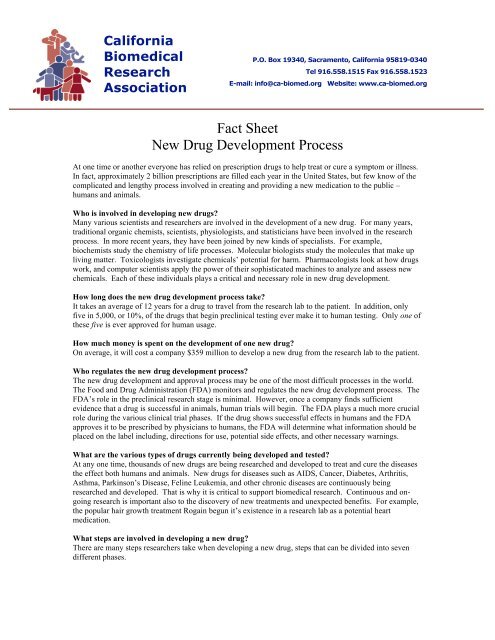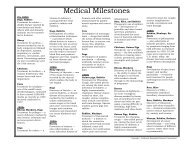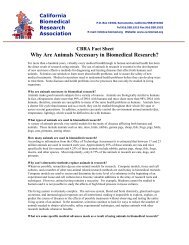Fact Sheet New Drug Development Process - California Biomedical ...
Fact Sheet New Drug Development Process - California Biomedical ...
Fact Sheet New Drug Development Process - California Biomedical ...
Create successful ePaper yourself
Turn your PDF publications into a flip-book with our unique Google optimized e-Paper software.
<strong>California</strong><br />
<strong>Biomedical</strong><br />
Research<br />
Association<br />
P.O. Box 19340, Sacramento, <strong>California</strong> 95819-0340<br />
Tel 916.558.1515 Fax 916.558.1523<br />
E-mail: info@ca-biomed.org Website: www.ca-biomed.org<br />
<strong>Fact</strong> <strong>Sheet</strong><br />
<strong>New</strong> <strong>Drug</strong> <strong>Development</strong> <strong>Process</strong><br />
At one time or another everyone has relied on prescription drugs to help treat or cure a symptom or illness.<br />
In fact, approximately 2 billion prescriptions are filled each year in the United States, but few know of the<br />
complicated and lengthy process involved in creating and providing a new medication to the public –<br />
humans and animals.<br />
Who is involved in developing new drugs?<br />
Many various scientists and researchers are involved in the development of a new drug. For many years,<br />
traditional organic chemists, scientists, physiologists, and statisticians have been involved in the research<br />
process. In more recent years, they have been joined by new kinds of specialists. For example,<br />
biochemists study the chemistry of life processes. Molecular biologists study the molecules that make up<br />
living matter. Toxicologists investigate chemicals’ potential for harm. Pharmacologists look at how drugs<br />
work, and computer scientists apply the power of their sophisticated machines to analyze and assess new<br />
chemicals. Each of these individuals plays a critical and necessary role in new drug development.<br />
How long does the new drug development process take?<br />
It takes an average of 12 years for a drug to travel from the research lab to the patient. In addition, only<br />
five in 5,000, or 10%, of the drugs that begin preclinical testing ever make it to human testing. Only one of<br />
these five is ever approved for human usage.<br />
How much money is spent on the development of one new drug?<br />
On average, it will cost a company $359 million to develop a new drug from the research lab to the patient.<br />
Who regulates the new drug development process?<br />
The new drug development and approval process may be one of the most difficult processes in the world.<br />
The Food and <strong>Drug</strong> Administration (FDA) monitors and regulates the new drug development process. The<br />
FDA’s role in the preclinical research stage is minimal. However, once a company finds sufficient<br />
evidence that a drug is successful in animals, human trials will begin. The FDA plays a much more crucial<br />
role during the various clinical trial phases. If the drug shows successful effects in humans and the FDA<br />
approves it to be prescribed by physicians to humans, the FDA will determine what information should be<br />
placed on the label including, directions for use, potential side effects, and other necessary warnings.<br />
What are the various types of drugs currently being developed and tested?<br />
At any one time, thousands of new drugs are being researched and developed to treat and cure the diseases<br />
the effect both humans and animals. <strong>New</strong> drugs for diseases such as AIDS, Cancer, Diabetes, Arthritis,<br />
Asthma, Parkinson’s Disease, Feline Leukemia, and other chronic diseases are continuously being<br />
researched and developed. That is why it is critical to support biomedical research. Continuous and ongoing<br />
research is important also to the discovery of new treatments and unexpected benefits. For example,<br />
the popular hair growth treatment Rogain begun it’s existence in a research lab as a potential heart<br />
medication.<br />
What steps are involved in developing a new drug?<br />
There are many steps researchers take when developing a new drug, steps that can be divided into seven<br />
different phases.
Preclinical Research<br />
The first place researchers start is in the lab. Preclinical research is the process where scientists<br />
and researchers determine what germs, viruses, or bacteria cause a specific disease. Once this is<br />
accomplished, researchers and scientists will work to break down the different components that<br />
make up a disease to find out what abnormal events or processes are taking place in the body.<br />
Scientists then work to develop a drug that will treat these abnormalities by conducting<br />
experiments in test tubes where they will add various compounds to enzymes, cell cultures, or<br />
cellular substances. The goal is to determine which compound additions result in some sort of<br />
chemical effect on the disease. Whenever possible, scientists will use computer models to test<br />
different compounds, however, computers don’t provide any final answers. These compounds still<br />
have to be placed into a living biological system to see if they work. Therefore, after successes in<br />
the “Benchtop” process (test tubes and cell cultures), scientists then test these compounds that<br />
have shown some desired effects in living animals. The entire process of preclinical research can<br />
take up to three and a half years. Once the process is complete, a pharmaceutical company will<br />
then file an Investigational <strong>New</strong> <strong>Drug</strong> Application (IND) with the FDA.<br />
Investigational <strong>New</strong> <strong>Drug</strong> (IND) Application<br />
The IND becomes effective if the FDA approves it within thirty days. At this time a<br />
pharmaceutical company can begin to test the potential new drug in humans. This process<br />
includes three phases of clinical trials.<br />
Phase 1 Trials<br />
A new drug is administered to approximately 20 to 80 healthy volunteers, to study the activity and<br />
monitor potential toxicity in people. This process takes about one year and if successful, will lead<br />
to phase II clinical trials.<br />
Phase II Trials<br />
During the phase II trials, the drug is given to 100 to 300 volunteers with the disease being studied<br />
to determine the drugs effectiveness. Proper dosages are established during this time. This<br />
process can take about two years to complete before moving to phase III clinical trials.<br />
Phase III Trials<br />
This phase involves anywhere from 1,000 to 3,000 volunteers with the specific disease that are in<br />
clinics or hospitals. Physicians will monitor these patients closely to determine the effects of the<br />
drugs and determine if any side effects are involved. This phase confirms if the drug is effective<br />
and safe and can take about three years.<br />
<strong>New</strong> <strong>Drug</strong> Application (NDA)<br />
After all three phases of clinical trials have been completed successfully a pharmaceutical<br />
company must file a <strong>New</strong> <strong>Drug</strong> Application (NDA) with the FDA. The pharmaceutical company<br />
must be able to clearly demonstrate the effectiveness and safety of the drug and must provide all<br />
of the scientific information the pharmaceutical company has collected on the specific drug. The<br />
FDA can take up to six months to review the application. Often times, this process takes longer<br />
than six months.<br />
Approval<br />
If the FDA approves the drug, it is then made available for physicians to prescribe to patients. The<br />
pharmaceutical company is still responsible for submitting periodic reports to the FDA regarding<br />
any unknown side effects that may occur after approval. For some medications, the FDA requires<br />
additional studies after approval. These are known as Phase IV Clinical Trials and serve to<br />
determine if there are any long-term side effects.<br />
*Please note, some of the above information was obtained by the FDA Special Consumer Report: The<br />
Beginnings: Laboratory and Animal Studies; <strong>Drug</strong> Safety Testing <strong>Fact</strong> <strong>Sheet</strong>; Alliance Pharmaceuticals,<br />
Corporation; and the Congressional Office of Technology Assessment.<br />
TO SUPPORT THE ADVANCEMENT OF HUMAN AND ANIMAL HEALTH BY PROMOTING AND PROTECTING BIOMEDICAL<br />
RESEARCH AND TEACHING.





